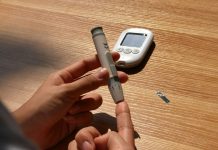General Electric recently announced the launching of its wireless handheld ultrasound device, Vscan Air, as the company looks to speed up diagnostic and examination processes without sacrificing quality. GE launched its first handheld ultrasound device in 2010 and has since been working to further provide a small-scale solution for time-sensitive situations.
According to GE, this device is one of the smallest and lightest on the market. The Vscan Air offers healthcare professionals both shallow and deep examination capabilities through its dual sided probes. Its software is also capable of scanning and image capturing and freezing. The battery powered device pairs with an app that can be downloaded on the user’s iPhone or Android device and can be used to share information with the patient.
On the patient side, Vscan Air offers a less invasive experience when compared to console-based ultrasounds. With healthcare providers carrying the device on their person, more time can be dedicated to discussion and other cases, allowing for a more personalized experience.
GE President and Chief Executive Officer of Global Ultrasound Anders Wold said, “Now more than ever, clinicians need smaller and smarter tools that increase access and efficiency both in and outside of the four walls of the hospital.”
Vscan Air can be adopted by emergency rooms, doctors’ offices, urgent care locations, and other facilities in need of fast quality results. Within the last year, the market for portable, fast-paced machines has grown in order to facilitate access and diagnose possible COVID-19 symptoms. GE has estimated a $1 billion increase in the handheld ultrasound market in the next decade. Competitors such as Butterfly Network and Philips are also working in the pocket-sized ultrasound market. Nevertheless, GE looks to use its background in ultrasound machinery to seize 30% of the market increase by 2025.
The Vscan Air will allow clinicians to more easily examine and diagnose internal medical conditions, increasing both convenience and speed in point of care treatments. The device will be available in the United States and Europe beginning April 1. Other countries eagerly await regulatory approval.























